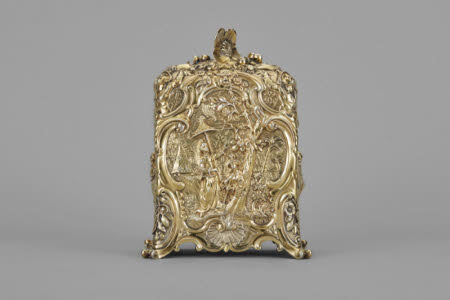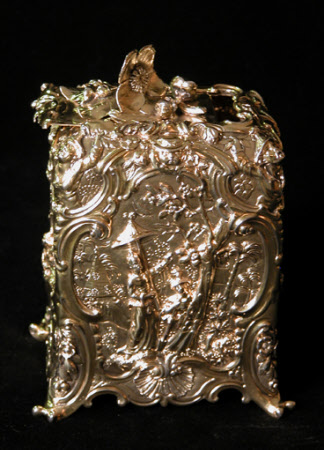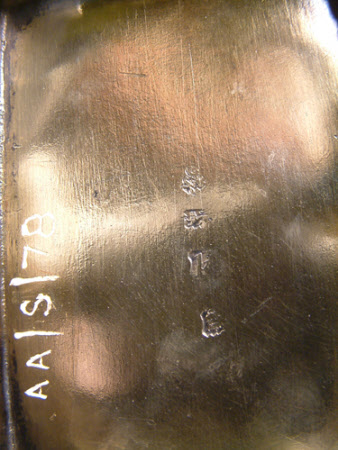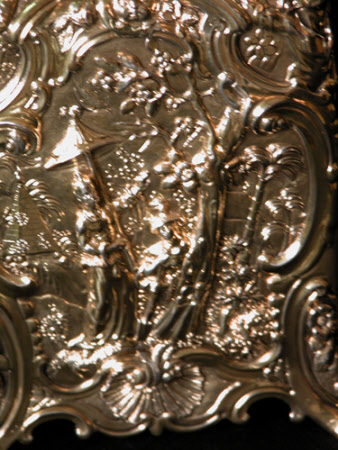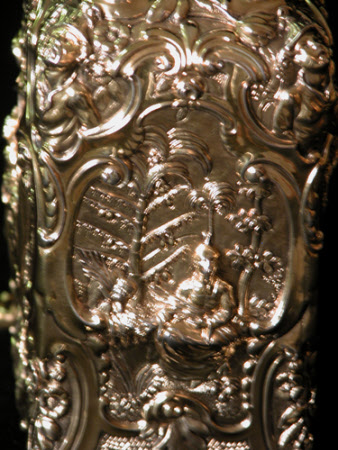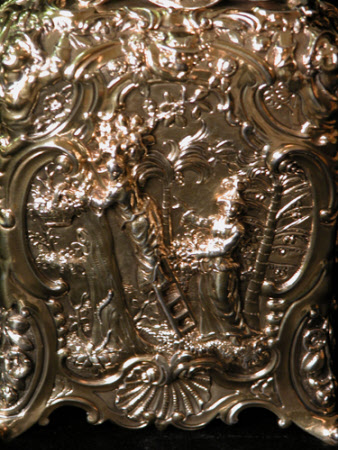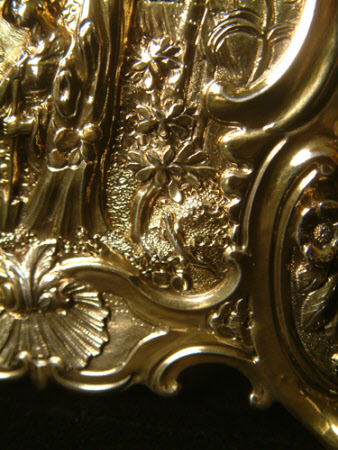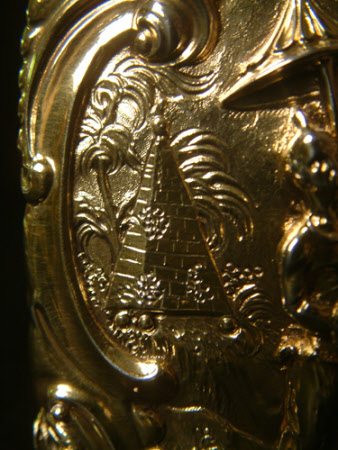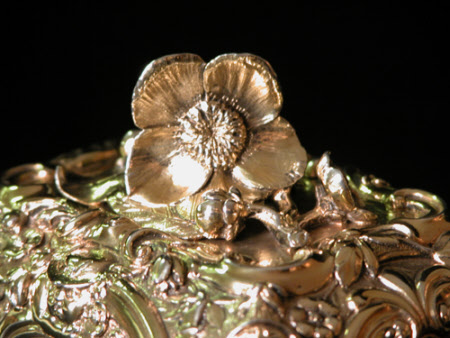Tea caddy
Frederick Kandler (d.1778)
Category
Silver
Date
1745 - 1746
Materials
Silver-gilt, sterling
Measurements
17.5 x 13.1 x 9.3 cm; 10.9 cm (Width); 8 cm (Width); 920 g (weight); 810 g (weight); 110 g (weight)
Place of origin
London
Order this imageCollection
Anglesey Abbey, Cambridgeshire
NT 516469
Summary
A tea caddy, silver-gilt (sterling), mark of Frederick Kandler, London, 1745/6. The rectangular caddy is made of four heavy gauge cast panels, finely chased with Chinoiserie decoration, seamed down the sides and to the flat base; with a flat sliding cover. Each side depicts a different vignette of exotic figures in luxuriant gardens surrounded by rococo cartouches of scrolls, masks, diaperwork, shells and small vignettes of flowers. Applied to the caddy’s serpentine apron are four small everted scroll feet. The caddy’s upper corners are formed as the torso of a cherub wearing a hat, and holding flowers or fruit in a raised arm. Three sides of the rectangular rim are applied with a border of scrolls and flowers. One side of the flat sliding cover is applied with a matching border, so that when the cover is closed the border is complete. The centre of the cover is chased with a rococo framed panel of matting, and applied with a large cast finial of prunus flowers, buds and leaves. Heraldry: None Hallmarks: Fully marked on the underside of the caddy: ‘FK’ (Frederick Kandler*), lion passant (sterling), ‘k’ (1745/6), and leopard’s head (London). The cover is not marked *Arthur Grimwade: London Goldsmiths 1697-1837, London, 1990, p 60, no 691 Scratch weight: None
Full description
The earliest English tea caddies, sometimes called tea canisters, date from round 1700. (For a brief history of tea and tea caddies see 516462.) The great silversmith Paul de Lamerie is credited with introducing vignettes surrounded by an exuberance of rococo decoration onto the sides of his oblong, sometimes bombé, caddies. In 1738/9 he made a spectacular pair of caddies and a matching sugar box; their sides covered in a riot of decoration round engraved landscapes. [1] Just a few years later he and several of his contemporaries, including Frederick Kandler, Thomas Heming, and Daniel Smith & Robert Sharp, produced similar caddies depicting figures in Oriental dress picking tea or sugar cane, or walking in fantastical gardens framed with scrolls, shells and prunus flowers. [2, 3 and 4] The flat sliding covers are topped with a cast finial in the form of a spray of prunus flowers or a seated Oriental figure. Some of Kandler’s and de Lamerie’s caddies have the four upper corners capped with the plump heads of hatted cherubs. Whilst the vignettes and their frames often bear similarities, they are not necessarily identical, indicating that the caddies’ designers sought inspiration from contemporary prints. Although when different makers produced identical objects, it was because they shared moulds, bought parts from the same mould maker, or stamped their hallmark on another’s work. [1] The Metropolitan Museum of Art, New York: Accession Number: 2022.254a–g [2] Christie’s, London: Beyreuth Sale, 7 July 2023, lot 128, a tea caddy with the mark of Paul de Lamerie, London 1744/5 [3] The Viginia Museum of Fine Art: Object Number: 97.28.1; a pair of tea caddies with the mark of Paul de Lamerie, London 1751/2 [4] Mallams, Oxford: Jewellery, Watches & Silver, 15 & 16 November 2023, lot 723, a tea caddy with the mark of Daniel Smith & Robert Sharp, London, 1762 Jane Ewart, 2025
Provenance
Christie’s inventory of Anglesey Abbey’s silver, commissioned by the National Trust in 1971, suggests the caddy came from Osterley Park (Urban) Huttleston Rogers Broughton, 1st Baron Fairhaven (1896-1966) bequeathed by Lord Fairhaven to the National Trust along with the house and the rest of the contents National Trust
Credit line
Anglesey Abbey, the Fairhaven Collection (National Trust)
Makers and roles
Frederick Kandler (d.1778), goldsmith

